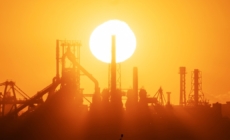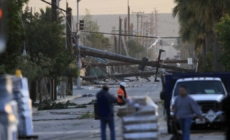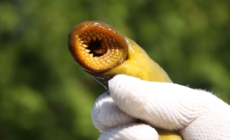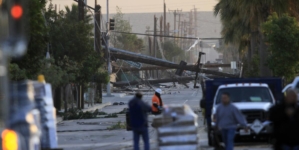-
O.C. teacher who allegedly sent sexually explicit texts is arrested - 22 mins ago
-
Japanese steelmaker vows not to give up on buying U.S. Steel - 31 mins ago
-
California’s Biggest Reservoir Has Best January Start in at Least 15 Years - 36 mins ago
-
Verizon settlement payments go out to customers in measly amounts - 41 mins ago
-
USMNT's 'Camp Cupcake' returns with MLS filled squad! | SOTU - 47 mins ago
-
Hugh Jackman and Sutton Foster confirm their relationship with public gesture after months of romance rumors - 54 mins ago
-
Southern California faces most destructive winds since 2011 - about 1 hour ago
-
Parasitic ‘Vampire’ Fish Numbers Surge in Lake Superior - about 1 hour ago
-
First commercial flight since the fall of Assad lands in Syria’s capital - about 1 hour ago
-
CFPB sues Experian over “sham investigations” into consumer complaints - about 1 hour ago
Group defends conclusions after error found in black plastic utensil study
A recent study that recommended toxic chemicals in black plastic products be immediately thrown away included a math error that significantly overstated the risks of contamination, but its authors are standing by their conclusions and warn against using such products.
Published in the peer-reviewed journal Chemosphere, experts from the nonprofit Toxic-Free Future said they detected flame retardants and other toxic chemicals in 85% of 203 items made of black plastic including kitchen utensils, take-out containers, children’s toys and hair accessories.
The study initially said the potential exposure to chemicals found in one of the kitchen utensils approached the minimum levels the Environmental Protection Agency deemed a health risk.
But in an update to the study, the authors say they made an error in their calculations and the real levels were “an order of magnitude lower” than the EPA’s thresholds. The error was discovered by Joe Schwarcz, director of McGill University’s Office for Science and Society in Canada.
In a blog post, Schwarcz explained that the Toxin-Free Future scientists miscalculated the lower end of what the EPA considered a health risk through a multiplication error. Instead of humans being potentially exposed to a dose of toxic chemicals in black plastic utensils near the minimum level that the EPA deems a health risk, it’s actually about one-tenth of that.
Though Schwarcz said the risks outlined in the study aren’t enough for him to discard his black plastic kitchen items if he had them, he agreed with the authors that flame retardants shouldn’t be in these products in the first place.
“The math error does not impact the study’s findings, conclusions or recommendations,” said Megan Liu, a co-author of the study who is the science and policy manager for Toxic-Free Future. She added that any traces of flame retardants or toxic chemicals in cooking utensils should be concerning for the public.
Flame retardants are getting into commonly used items because black-colored products are being made from recycled electronic waste, such as discarded television sets and computers, that frequently contain the additives. When they’re heated, the flame retardants and other toxic chemicals can migrate out.
If you’re wondering whether your old black plastic spoon or other utensils are a part of this group, Liu shared some more guidance.
Generally, how do I know a product is harmful?
It’s nearly impossible to know whether a black plastic product is contaminated. That’s because these products that include recycled e-waste don’t disclose a detailed list of all ingredients and contaminants in the product.
Liu said it’s also unclear how many types of flame retardants are in these black plastic products.
Some of the products that researchers tested in this recent study “had up to nine different harmful chemicals and harmful flame retardants in them,” she said.
How can I find out if black plastic food trays are made with recycled contaminated plastic?
Anytime you’re looking for the type of recycled plastic a product is made of you’re going to look for a number within the chasing arrows (that form a triangle) logo.
Recycling symbols are numbered 1 to 7 and we commonly associate the numbers with what we can toss in our blue recycling bins. The 1 through 7 numbers stand for, respectively, polyethylene terephthalate, high-density polyethylene, polyvinyl chloride (PVC), low-density polyethylene, polypropylene, polystyrene or Styrofoam, and miscellaneous plastics (including polycarbonate, polylactide, acrylic, acrylonitrile butadiene, styrene, fiberglass and nylon).
The study found higher levels of toxic flame retardants in polystyrene plastic, which is labeled with the number 6, said Liu.
When did recycled e-waste begin contaminating black plastic products?
There isn’t a definitively timeline of when recycled electronic-waste started to be incorporated into black plastic products specifically, but e-waste started to get recycled in the early 2000s, Liu said.
The way computers, cellphones, stereos, printers and copiers were being disposed of previously was to simply add them to a landfill without reusing salvageable parts.
But as the National Conference of State Legislatures notes, electronics production required a significant amount of resources that could be recovered through recycling.
Recovering resources such as metals, plastics and glass through recycling used a fraction of the energy needed to mine new materials.
However, the study pointed out that flame retardants and other chemical contaminates have been detected in and near e-waste recycling facilities, in indoor air and dust at formal e-waste recycling facilities in Canada, China, Spain and the U.S. It also noted contamination in soil samples surrounding e-waste recycling sites in China and Vietnam.
What are safer alternatives?
The safest nontoxic material options for kitchen utensil are wood and stainless steel.
Source link































